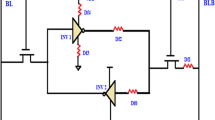Abstract
In low-power SRAMs, power gating mechanisms are commonly used to reduce static power consumption. When the SRAM is not accessed for a long period, such mechanisms allow shutting off one or more memory blocks (core-cell array, address decoder, I/O logic, etc.), thus reducing leakage currents. In order to guarantee static power reduction in low-power SRAMs, reliable operation of power gating mechanisms must be ensured by adequate test techniques. In this paper, we first present a detailed analysis based on electrical simulations to identify faulty behaviors caused by realistic defects that may affect power gating mechanisms embedded in low-power SRAMs. Based on this analysis, we present an efficient test solution targeting detection of observed faulty behaviors. As a final contribution, we propose novel techniques to mitigate the impact of studied defects, once detected by test methods, therefore providing significant yield improvement.








Similar content being viewed by others
References
Agarwal A, Mukhopadhyay S, Kim CH, Raychowdhury A, Roy K (2005) Leakage power analysis and reduction: models, estimation and tools. IEE Computers and Digital Techniques 152(3):353–368
Bosio A, Dilillo L, Girard P, Virazel A, Pravossoudovitch S (2009) Resistive-open defects in core-cells. Advanced test methods for SRAMs effective solutions for dynamic fault detection in nanoscale technologies, Springer, ISBN: 978-1-4419-0937-4
Choi H, Kim K (2007) Cascade wake-up circuit preventing power noise in memory device. U.S. Patent 7 193 921 B2
Cory BD, Kapur R, Underwood B (2003) Speed binning with path delay test in 150-nm technology. IEEE Design & Test of Computers 20(5):41–45
Datta A, Bhunia S, Jung HC, Mukhopadhyay S (2008) Profit aware circuit design under process variations considering speed binning. IEEE Transactions on Very Large Scale Integration (VLSI) Systems 16(7):806–815
Dray C, Badereddine N, Chanussot C (2010) A 40 nm low power SRAM retention circuit with PVT-aware self-refreshing virtual VDD regulation. Proc. of Memory Workshop (IMW), 1–4
Goel SK, Meijer M, de Gyvs JP (2006) Testing and diagnosis of power switches in SOCs. Proc of European Test Symposium 2006:145–150
Hamdioui S, Al-Ars Z, van de Goor AJ, Rodgers M (2003) Dynamic faults in random-access-memories: concept, fault models and tests. Journal of Electronic Testing: Theory and Applications 19(2):195–205
Hamdioui S, Wadsworth R, Reyes JD, Van De Goor AJ (2004) “Memory fault modeling trends: a case study”. J Electron Test 20(3):245–255
Hamdioui S et al (2010) March SS: A test for all static simple RAM faults. Proc of IEEE MTDT 2002:95–100
Irobi S, Al-Ars Z, Hamdioui S (2010) Detecting Memory Faults in the Presence of Bit Line Coupling in SRAM devices. Proc. of IEEE Internationl Test Conference, pp 1-10
Itoh K (2002) Low voltage memories for power-aware systems. Proc. of ISLPED, 1–6.
Kawahara T, Itoh K (2006) Leakage in Nanometer CMOS Technologies. In: Narendra SG, Chandrakasan A (eds) Memory leakage reduction - SRAM and DRAM specific leakage reduction techniques. Springer, New York, pp 163–199
Khursheed S, Sheng Y, Al-Hashimi BM, Xiaoyu H (2011) Improved DFT for Testing Power Switches. Proc. of European Test Symposium, pp 7-12
Lee CF, Lin W, Lai FS, Lin SC (2007) On-chip VDC circuit for SRAM power management. Proc. of International Symposium on VLSI Design, Automation and Test, pp 1–4
Roy K, Mukhopadhyay S, Mahmoodi-Meimand H (2003) Leakage current mechanism and leakage reduction techniques in deep-submicrometer CMOS circuits. Proc of IEEE 91(2):305–327
Semiconductor Industry Association (SIA) (2011) International Technology Roadmap for Semiconductors (ITRS)
Tseng T-M, Chao MC-T, Lu C-P, Lo C-H (2009) Power-switch routing for coarse-grain MTCMOS technologies. International Conference on, Computer Aided Design, pp 39–46
van de Goor AJ (1991) Testing semiconductor memories: theory and practice. Wiley, Chichester
van de Goor AJ (1993) Using march tests to test SRAMs. IEEE Design & Test of Computers 10(1):8–14
Wang J, Calhoun BH (2008) Techniques to extend canary-based standby VDD scaling for SRAMs to 45 nm and beyond. IEEE Journal of Solid State Circuits 43(11):2514–2523
Wang J, et al (2007) Statistical modeling for the minimum standby supply voltage of a full SRAM Array. Proc. of 33rd European Solid State Circuits Conference, pp 400–403
Wang Y, Bhattacharya U, Hamzaoglu F, Kolar P, Yong-Gee N, Liqiong W, Ying Z, Zhang K, Bohr M (2010) A 4.0 GHz 291 Mb voltage-scalable SRAM design in a 32 nm high-k+ metal-gate CMOS technology with integrated power management. IEEE Journal of Solid State Circuits 45(1):103–110
Yamauchi H (2007) Embedded SRAM circuit design technology for 45 nm and beyond. Proc. of ASIC, pp 1028–1033
Zordan LB, Bosio A, Dilillo L, Girard P, Todri A, Virazel A, Badereddine N (2013) A built-in scheme for testing and repairing voltage regulators of low-power SRAMs. Proc. of IEEE VLSI Test Symposium, pp 1–6
Zordan LB, Bosio A, Dilillo L, Girard P, Todri A, Virazel A, Badereddine N (2012) Low-power srams power mode control logic: failure analysis and test solutions. Proc. of IEEE Int. Test Conference, paper 14.3
Author information
Authors and Affiliations
Corresponding author
Additional information
Responsible Editor: S. Hamdioui
This paper is an extended version of a previously published paper [26]. Main contributions of this paper with respect to [26] are:
• A more detailed analysis of experimental results that characterize the impacts of studied resistive-open defects.
• A comprehensive analysis of experimental results showing that the impacts of the most critical defect (Df6) can be mitigated at the expense of increased wake up time or clock cycle.
• A more detailed analysis of conditions to coverage faulty behaviors caused by Df6.
• A detailed and comprehensive analysis on techniques to estimate the adjusted wake up time and clock cycle that must be used to in order to mitigate the impact of Df6 on SRAM devices that are in presence of such defect.
Rights and permissions
About this article
Cite this article
Bonet Zordan, L.H., Bosio, A., Dilillo, L. et al. On the Test and Mitigation of Malfunctions in Low-Power SRAMs. J Electron Test 30, 611–627 (2014). https://doi.org/10.1007/s10836-014-5479-z
Received:
Accepted:
Published:
Issue Date:
DOI: https://doi.org/10.1007/s10836-014-5479-z




